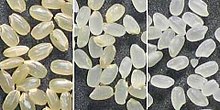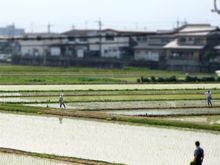Japanese rice
This article needs additional citations for verification. (December 2016) |


Japanese rice refers to a number of short-grain cultivars of Japonica rice including ordinary rice (uruchimai) and glutinous rice (mochigome).
HI egar]].
Uncooked brown rice grains are mixed with green tea leaves and used to brew a kind of tea called Genmaicha (玄米茶) (brown rice tea).
Glutinous rice, known in Japan as mochigome, is used for making mochi (餅), the festive red bean and rice dish sekihan, as well as traditional snacks such as senbei (煎餅), arare (あられ), and agemochi (揚げ餅).
Preparation
Most Japanese use suihanki (rice cookers) to which measured amounts of washed rice and water are added. The rice is first washed to release excess starch. Then, before cooking it is usually soaked in water for between half an hour in summer, and two hours in winter. Soaking times also depend on the quality and freshness of the rice. The rice is then boiled using a ratio of about five parts of water to four parts of rice – though with fresher rice, the ratio can go down to 1-to-1. After this, it is steamed until the centre of the rice becomes soft. Salt is not added to the rice.
Most modern rice cookers include a cooking-delay timer, so that rice placed in the cooker at night will be ready for the morning meal. The rice cooker can also keep rice moist and warm, allowing it to remain edible for several hours after cooking.
Prepared rice is usually served from the rice cooker into a chawan, or rice bowl.
After cooking, rice may also be held in a covered wooden box called an ohitsu.
Trading
The Dojima Rice Market in Osaka was the first known futures market, with trading in rice contracts established sometime around 1730. This market ceased with economic controls in 1939. In 2005, the Tokyo Grain Exchange announced that it would create a futures contract on rice with trading starting in the summer of 2006.[1] However, the trading of these futures contracts has been postponed to an unspecified date since it has not been approved by the Japanese government.[2]
The Tokyo Grain Exchange was founded in 1952 in the same location as the Kakigaracho Rice Trading Exchange, established in 1874.[3] As of 2005, two varieties of Japanese rice were in consideration for standardization of the contract.
In order to fulfill self-sufficiency goals in Japan and to support domestic rice producers, the Japanese government enforces quotas and high tariffs on foreign rice. As a result, most rice consumed in Japan is domestically produced. However, price increases in recent years have led a small but increasing number of Japanese consumers and restaurants to seek out the small amount of less-expensive rice imported from China, Australia, and the United States that is available in Japan.[4]
See also
References
- ^ "[The Tokyo Grain Exchange]". Archived from the original on 2005-11-20. Retrieved 2020-01-04.
- ^ "Fia | Fia". Futuresindustry.org. Retrieved 2016-12-27.
- ^ "The Tokyo Grain Exchange". Archived from the original on 2005-05-07. Retrieved 2020-01-04.
- ^ Tabuchi, Hiroko. "Japanese Consumers Reconsidering Rice Loyalty". The New York Times. Retrieved 25 October 2012.

